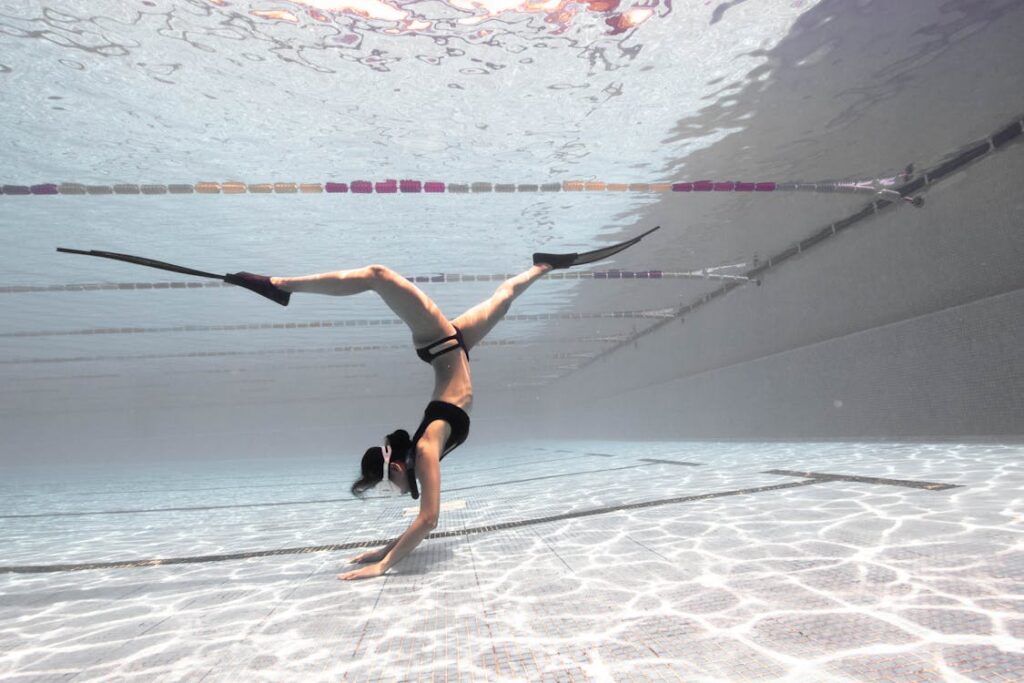
画像ソース: ペクセル
キックボードを使って水泳をすると、無限の可能性が広がります。このブログでは、この水中用具の奥深さを深く掘り下げ、そのメリットとデメリットを探っていきます。
脚力強化から怪我のリスクまで、キックボードを使った水泳のメリットを詳しく解説します。この水泳用アクセサリーの微妙なニュアンスを解き明かし、水泳にどのような影響を与えるかについて、ぜひ一緒に考えてみましょう。
キックボードを使用するメリット

脚力の向上
キックボード 水泳選手の脚力を強化するための貴重なツールです。
キックをアイソレートすることで、筋力だけでなく、持久力と爆発的なパワーも鍛えられます。その結果、全身を使ったスイミングパフォーマンスが実現し、他を圧倒します。キックボードを手に取り、キックでタイムを縮めましょう。
技術の向上
キックボードはキックの技術を習得するための秘密兵器です。
脚の動きを分離することで、テクニックを集中的に分析し、より力強く効率的なバタつきを鍛えることができます。脚の筋力だけでなく、泳ぎ全体を動かすエンジンを微調整することが重要です。キックするたびに、よりスムーズで速いストロークの基盤が築かれていきます。
浮力を提供する
水泳にキックボードを使用する主な利点の 1 つは、浮力が得られることです。
キックボードは、水泳中に上半身を支え、浮力を維持します。また、激しい運動中に短時間休憩を取ることができるため、水中でのスタミナと持久力が向上します。
キックボードのデメリット

怪我の可能性
肩の問題
キックボードの罠にご注意: 脚のトレーニングには最適ですが、このフォーム製の補助器具は肩を妨害する可能性があります。
反復運動と腕の固定された姿勢は肩に負担をかけ、痛みや怪我につながる可能性があります。肩の健康を保つには、正しいフォームを意識し、ルーティンに工夫を凝らしましょう。バランスの取れた水泳トレーニングは、長期的に怪我を防ぐ鍵となることを忘れないでください。
背中と首の緊張
水泳にキックボードを使用する場合のもう 1 つの欠点は、背中や首に負担がかかる可能性があることです。
キックボードを握る際の姿勢が適切でないと、背中や首の筋肉に不要な負担がかかります。負担を軽減するには、キックボードを使ったトレーニング中は、背骨をニュートラルな位置に保ち、背中を反りすぎないように注意しましょう。
技術的な問題
だらしない体勢
水泳でキックボードを使用する際に水泳選手が直面する一般的な問題の 1 つは、体勢が崩れてしまうことです。
ビート板につかまると、体のアライメントが崩れ、泳ぎ全体の姿勢に影響が出る可能性があります。体幹の筋肉を鍛え、体を流線型に保つことで、テクニックを向上させることができます。
異なるキックスタイル
ビート板を使用すると、通常の水泳とは異なるキックスタイルを採用する必要がある場合があります。
キックテクニックの違いは、全体的なストローク効率と筋肉の働きに影響を与える可能性があります。パフォーマンスを向上させるには、様々な水泳練習を通してキックスタイルの一貫性を保つように意識しましょう。
上半身の限定トレーニング
腕の筋肉を軽視する
キックボードは下半身の筋力強化には効果的ですが、トレーニング中に腕の筋肉を鍛えることを軽視する傾向があります。
ビート板だけに頼ると、水泳のストロークにおける推進力と協調性に不可欠な腕の筋力が十分に発達しない可能性があります。バランスの取れた筋肉の発達のために、上半身のトレーニングをルーチンに取り入れることを検討してください。
あまり包括的ではない演習
キックボードだけを使用すると、水泳トレーニングの多様性と包括性が制限される可能性があります。総合的なフィットネス向上を確実にするためには、様々な筋肉群や水泳パフォーマンスの側面をターゲットとした、様々なトレーニングツールとテクニックを組み合わせることが不可欠です。
水泳でキックボードを使う方法

適切なテクニックとポジショニング
キックボードを使った水泳トレーニング: プールフェンスDIYキックボードを使った水泳トレーニングの専門家であるは、正しいテクニックとポジショニングの重要性を強調しています。トレーニング効果を最大限に高めるには、キックボードで蹴る際は、流線型の体勢を維持することに集中しましょう。脚を力強く動かすことで、脚の筋肉を効果的に強化できます。
キックボードの使用と他の水泳練習のバランスをとる
キックボードを使ったエクササイズを水泳のルーティンに取り入れることで、他にはないメリットが得られます。他の水泳エクササイズとバランスよく組み合わせることで、様々な筋肉群を鍛え、全体的なパフォーマンスを向上させることができます。
水泳の技術を総合的に向上させるために、ビート板のドリルと従来の泳ぎ方を交互に行うことを検討してください。
推奨される使用期間と頻度
推奨される使用期間と使用頻度を考慮してください。
最適な結果を得るには、週2~3回キックボードワークアウトをルーチンに取り入れることを目標にしてください。最初は短いセッションから始め、脚の持久力と筋力が向上してきたら、徐々に時間を増やしていきましょう。
キックボードの代替品
プルブイ
プルブイは、太ももの間に配置されるフォーム製の装置です。
利点:
- 上半身を分離し、腕のテクニックと強さに集中できるようにします
- 体の位置と回転を改善する
- より強い引力を生み出すのに役立ちます
欠点:
- 上半身への過度の依存につながる可能性がある
- キック練習はできない
キックボード vs. プルブイ:
キックボードは、キックのスピードとテクニックの向上、キックの持久力の強化、全体的な水泳パフォーマンスの向上に重点を置いています。
一方、プルブイは、クロールと背泳ぎでの腕の動きを分離するのに役立ち、水泳中のコントロールを向上させます。
水泳用フィン

水泳用フィンは足に履くスリッパです。
利点:
- 脚の強さと足首の柔軟性を向上
- 体の位置とキックのテクニックを改善
- 水泳選手が効率的なキックの正しい動きを感じるのを助ける
欠点:
- 長時間使用すると足首に負担がかかる可能性があります
- 追加の推進力への依存につながる可能性がある
キックボード vs. 水泳用フィン:
キックボードは上半身に浮力を与え、新しい泳ぎ方を学ぶのに役立ちます。
水泳用フィンは、脚の筋肉を鍛え、バランスと呼吸を向上させ、溺れるリスクを減らすのに効果的です。
ハンドパドル
ハンドパドルは、表面積を増やすために手に取り付ける平らな装置です。
利点:
- 腕と肩を強化します
- 水の感覚とストロークのキャッチフェーズを改善します
- 手の入り方と引き抜き方を修正します
欠点:
- 不適切に使用すると肩に負担がかかる可能性がある
- 初心者や肩に問題のある方にはお勧めできません
キックボード vs. ハンドパドル:
キックボードは平泳ぎの脚の動きを分離し、水泳選手がキックのテクニックに集中できるようにします。
ハンドパドルは、さまざまな泳ぎ方で腕の動きを分離し、ストロークの効率を高め、全体的な推進力を高めるのに役立ちます。
キックボードを使うべき人は誰ですか?
初心者と上級者
初心者向けキックボードは、初心者スイマーにとって、脚力の強化とキックの持久力向上に欠かせないツールです。基本的なストロークテクニックの習得を助け、水中での安定性と自信を高めます。
キックボードトレーニングは、水泳スキルの強固な基礎を築くことに重点を置くため、初心者にとって有益です。
上級スイマー向け経験豊富なスイマーは、キックボードを活用して、ストロークの特定の側面を改良し、パフォーマンスを向上させることができます。
最後に
キックボードは、高度なドリルやテクニックの向上の機会を提供し、スイマーが重点的にトレーニングが必要な部位に集中して取り組むことを可能にします。キックボードを使ったエクササイズを上級者向けのトレーニングルーチンに取り入れることで、水中での効率とスピードを向上させることができます。
この記事でご紹介したように、ヨガは脚力、体勢、呼吸法の向上に役立つ貴重な補助器具です。しかし、ヨガには過度の依存や不適切な習慣を身につけてしまうリスクなど、潜在的な欠点も伴います。
キックボードを水泳のルーティンに取り入れるかどうかに関わらず、最も重要なのは継続的な練習と正しいテクニックの習得です。楽しい水泳を!



